|
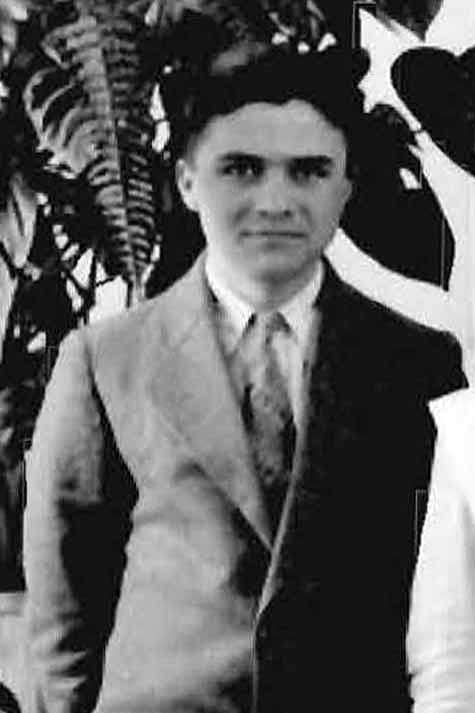
Joseph Hajdu, R.T., X-ray technician (at the San from
1930until it closed in 1964), and Martha Elizabeth (Somerville) Hajdu, R.N. (nurse in the late 1930s), at the Cresson Sanatorium
Joseph Hajdu, our father, went
to the Cresson Sanatorium in his early teens, October 1, 1925,
when he was 14 years old. This is the earliest picture we have found
of him at the San. He was sent there because he had a lung condition
that was later diagnosed as bronchiectasis, a chronic inflammation
of the bronchi caused by the whooping cough he had suffered when he
was two years old. Remarkably, he did not contract tuberculosis
there, but he was to stay in Cresson and work at the hospital and its
successor institutions for the rest of his career.
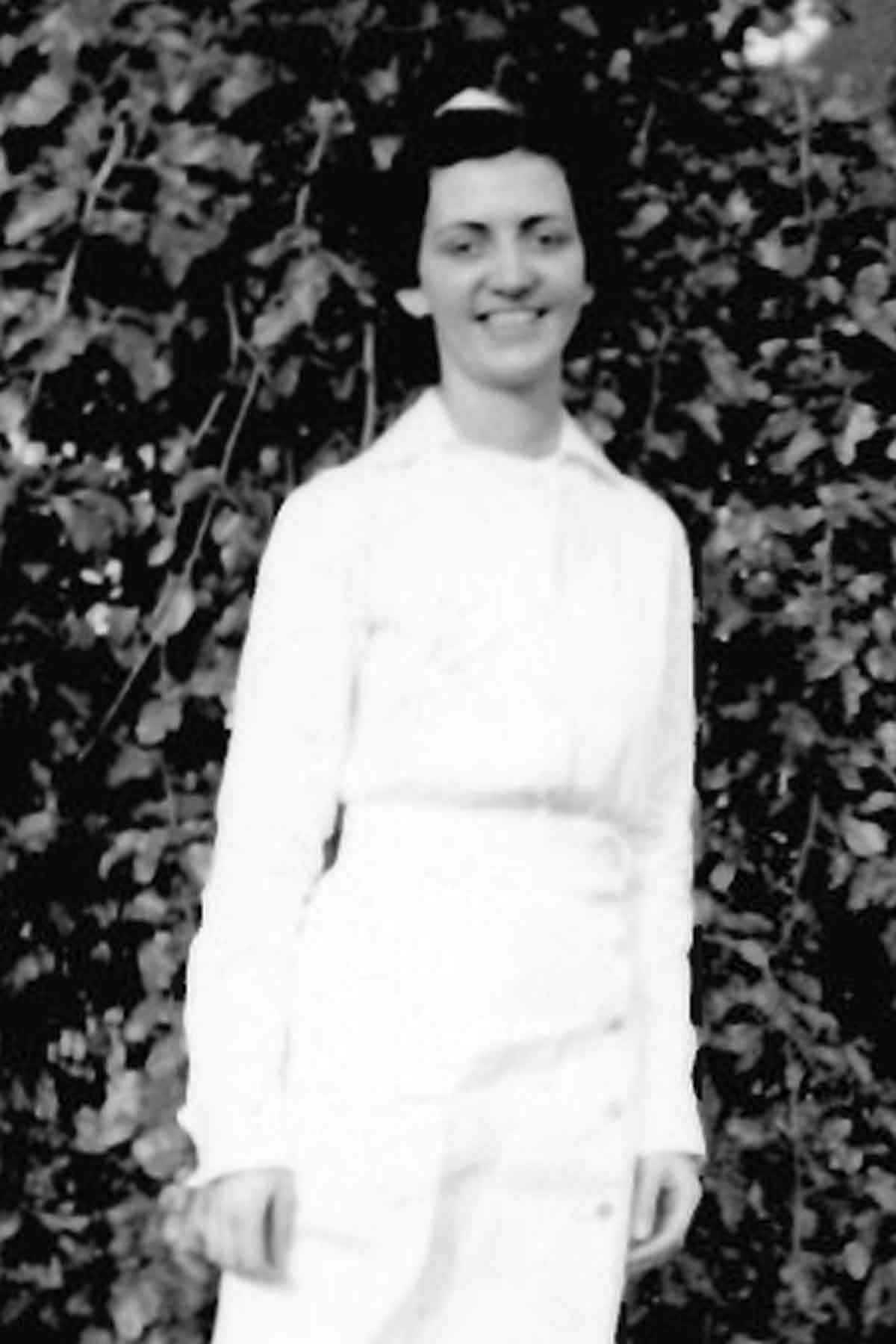 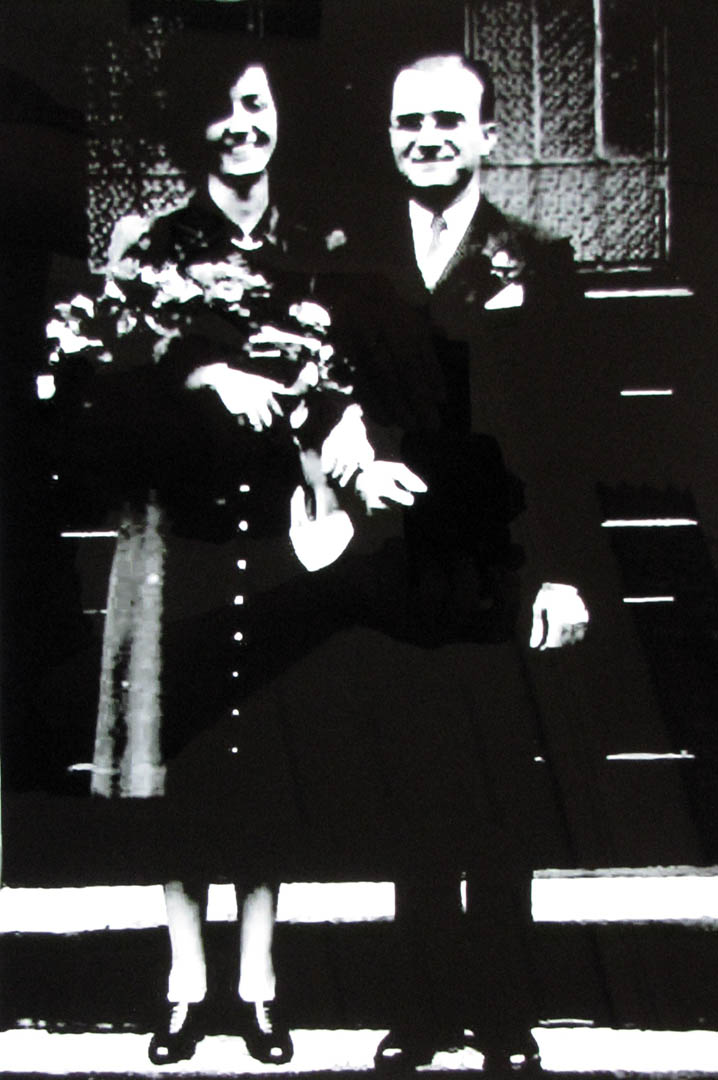
At the San Dad met our mother, Martha Elizabeth Somerville, a native of Ebensburg who somehow, remarkably, at the depth of the Depression, found
the resources to go to Temple University Nursing School for a two-year program. She
was the first of our family to achieve some higher education, something on which our parents placed an immense value –
they saw all their children achieve college degrees. She returned to Western
Pennsylvania to work at the San as a registered nurse in the mid-1930s and married our father in 1940. They set up housekeeping in Cresson and became active member s of that community and of the Methodist Church
there. They had three children, Joseph, John and Wilda. We have very little information on our mother’s career at the San. The picture to the right is of
Elizabeth and Joseph Hajdu on their wedding day.
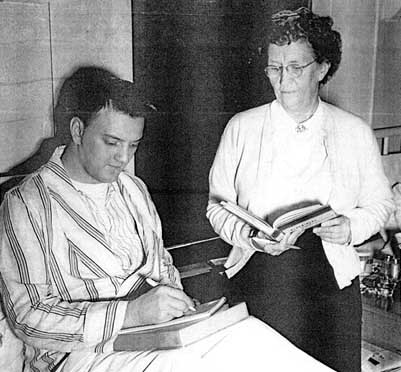
Dad had completed 7th grade before
coming to the San, where after several years he continued his schooling. His
teacher, Mary Mackereth, shown here with another patient (picture thanks to Chuck Felton’s page) became a life-long
friend of our family. Dad did not finish high school, however, until sometime
in the later, but he persisted until he had a high school diploma. Miss Mackereth was very kind to our family. She paid for the Hajdu children to go to a summer Bible camp, she patiently tutored John in Latin and math,
and she often came to our table during holidays. She was a highly versatile teacher,
as noted elsewhere in these pages. She was no doubt important in reinforcing
in our parents the high value that they held for education.
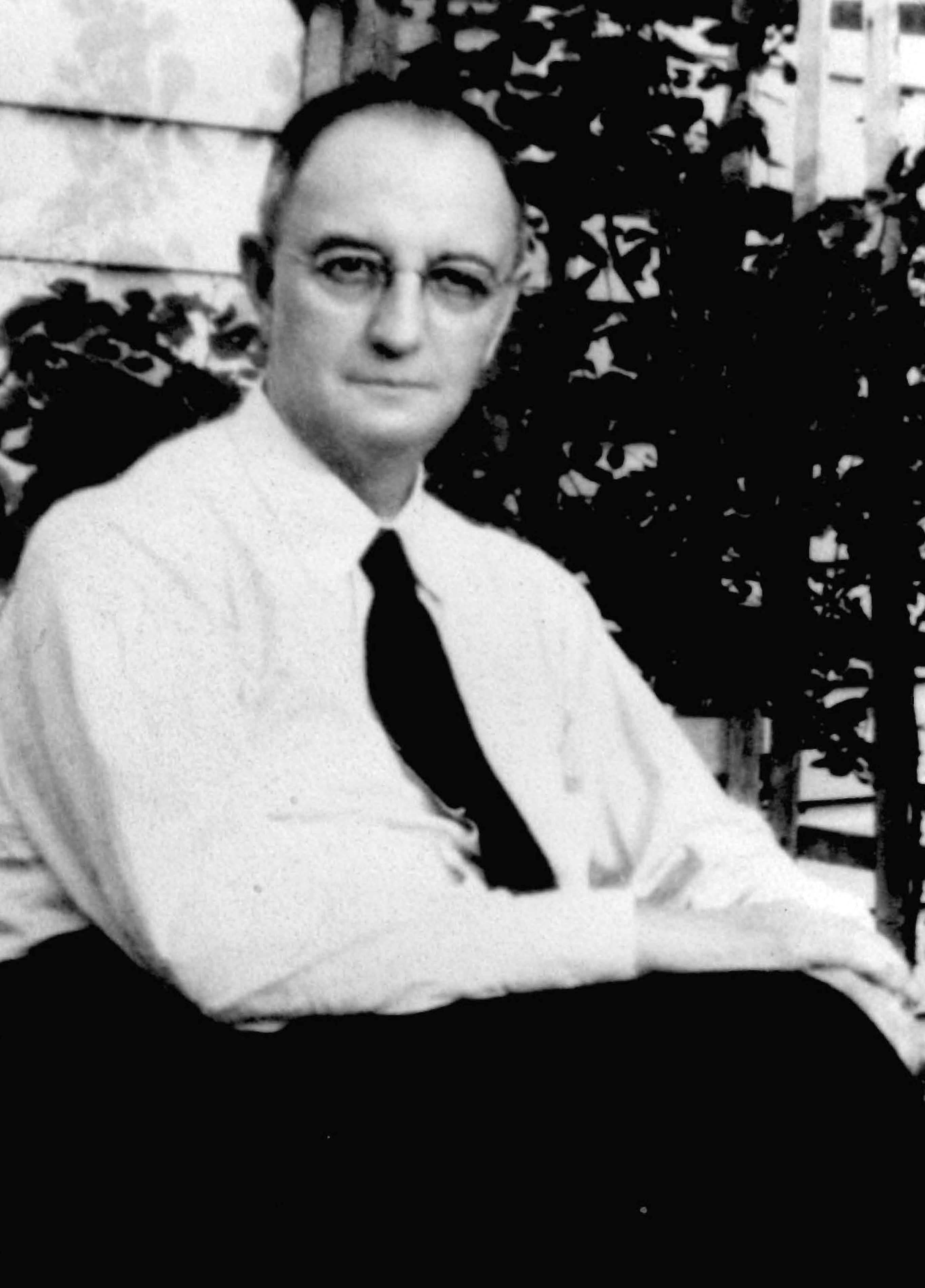
Another individual who was important to our family
was Dr. Melvin E. Cowen, who took an interest in our dad when he was still in his teens.
Dr. Cowen was instrumental in directing Dad to the emerging field of x-ray technology, at that time only about 20 years
old. Dad became the first x-ray technician at the San, and he worked in that
position for 37 years. Dr. Cowen was a high-level amateur photographer. Through his friendship Dad developed a life-long hobby in photography, aided by the
fact that as a trained x-ray technician he knew how to develop his own pictures. Dad’s
heritage was Hungarian. He spoke and could read and write Hungarian well, so
he took interest in Hungarians who came to the hospital. Another of his friends
was Hungarian, a professional photographer from Pittsburgh, Deszo Demetsky, who came to the San as a young patient about the
same time Dad arrived. We have many photos and undeveloped negatives, most of
which are Dad’s, but some clearly were Dr. Cowen’s and others probably were Deszo’s. Some of the photos are given below.
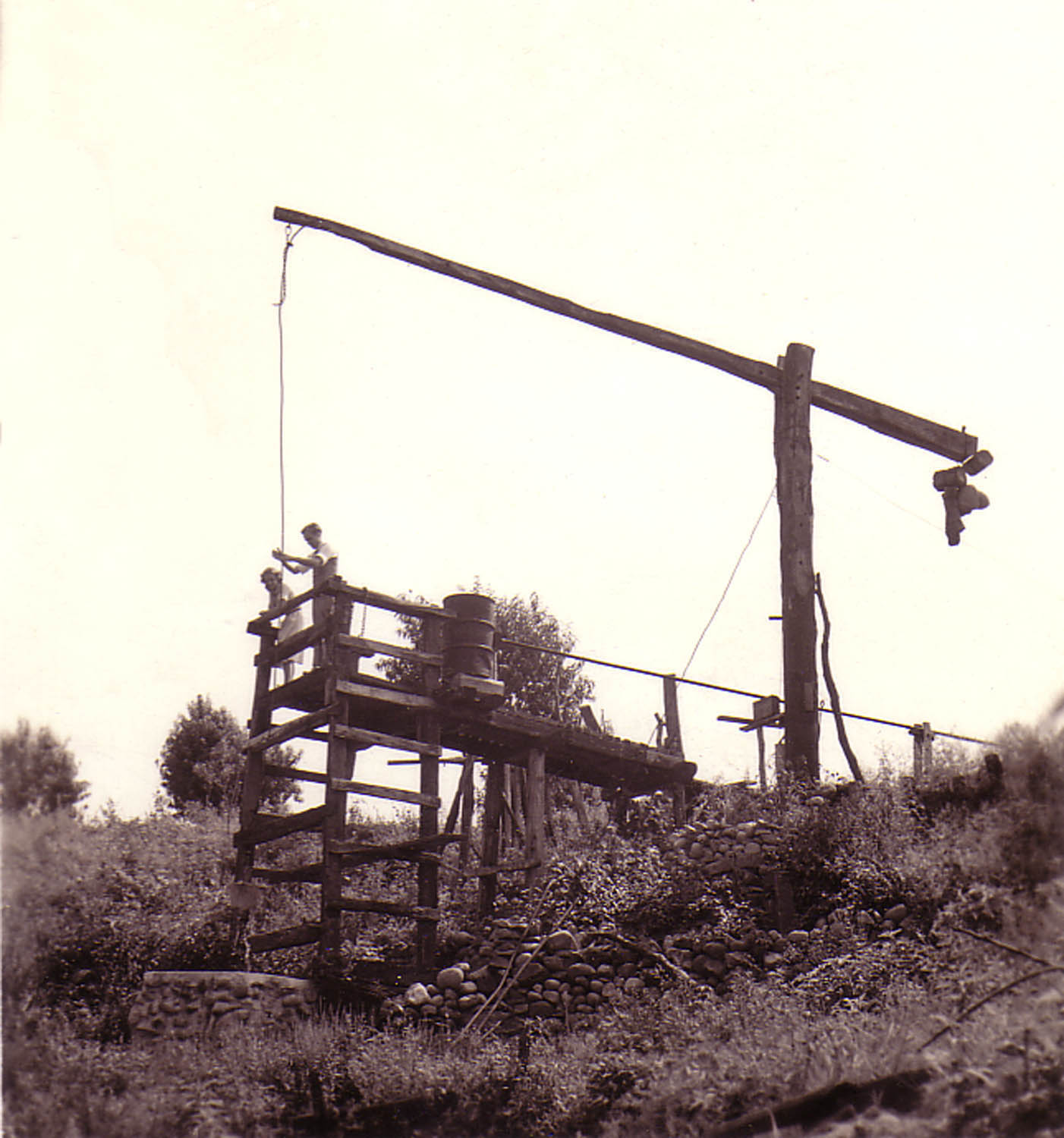 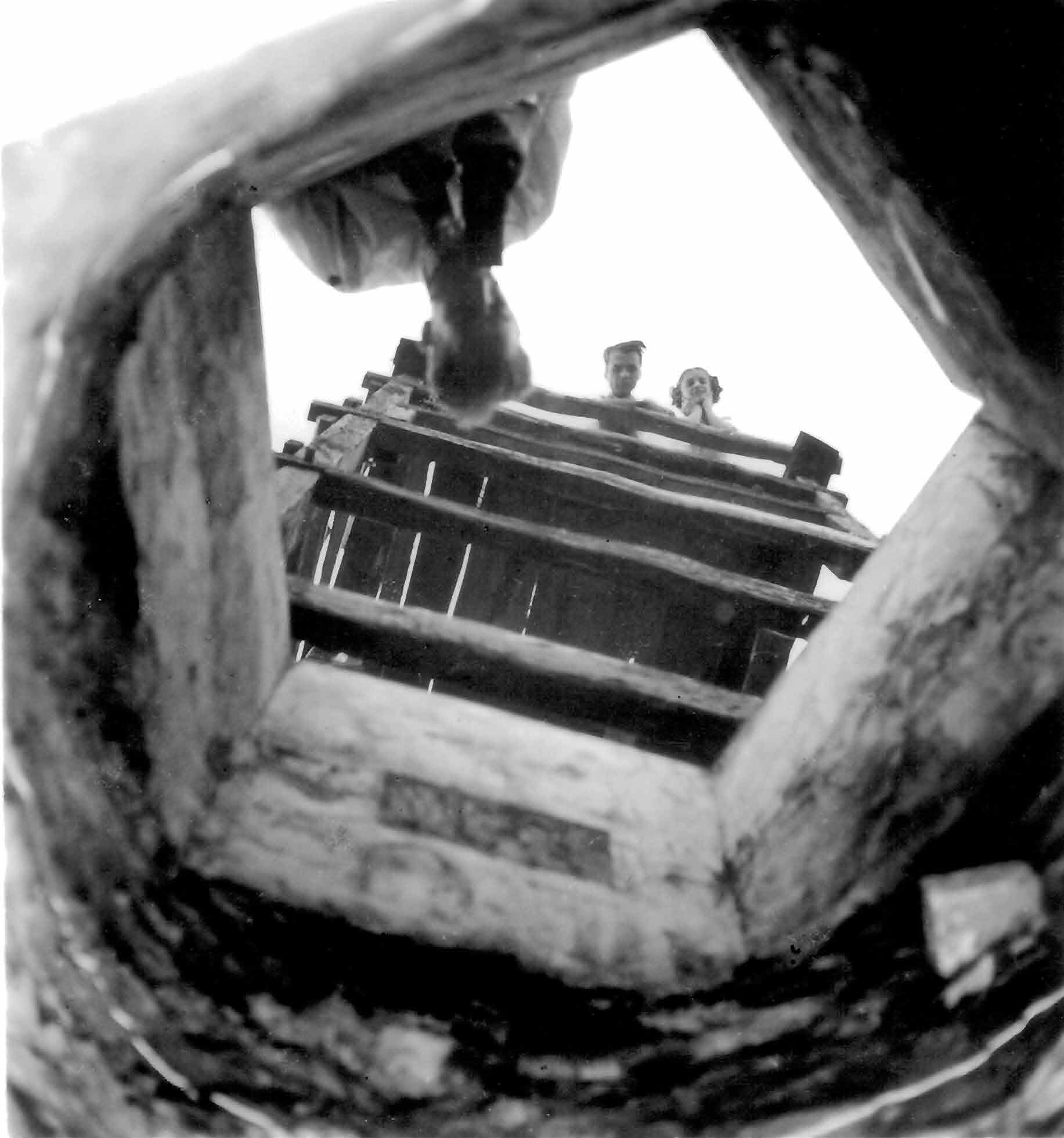
Dad maintained many friendships with people who
left the San. His friendship with Deszo Demetsky lasted for decades – we
have correspondence from as late as 1977. They were almost exactly the same age
– Deszo was a year older, so they were both in their mid-teens when they went to the San. Deszo, however, was released before 1929, for Dad mentions receiving letters from him that year. Deszo, like Dad, may not have had tuberculosis. He lived
in Pittsburgh, and when Dad would go to his home near Fayette City, he would travel through Pittsburgh and visit Deszo. On at least one occasion in the mid-1930s Deszo went to the Hajdu farm near Fayette
City with Dad. Deszo took the two pictures here, among others. The one on the left shows our grandfather’s ingenious Hungarian well that was developed with a lift
so the house could have running water from an elevated cistern. The photo on
the right is a view into the Hajdu farm well, so the photo is actually a reflection.
You can see Deszo holding the camera over the edge of the well, and Joseph Hajdu and his younger sister Ethel in the
reflection appearing behind Deszo.
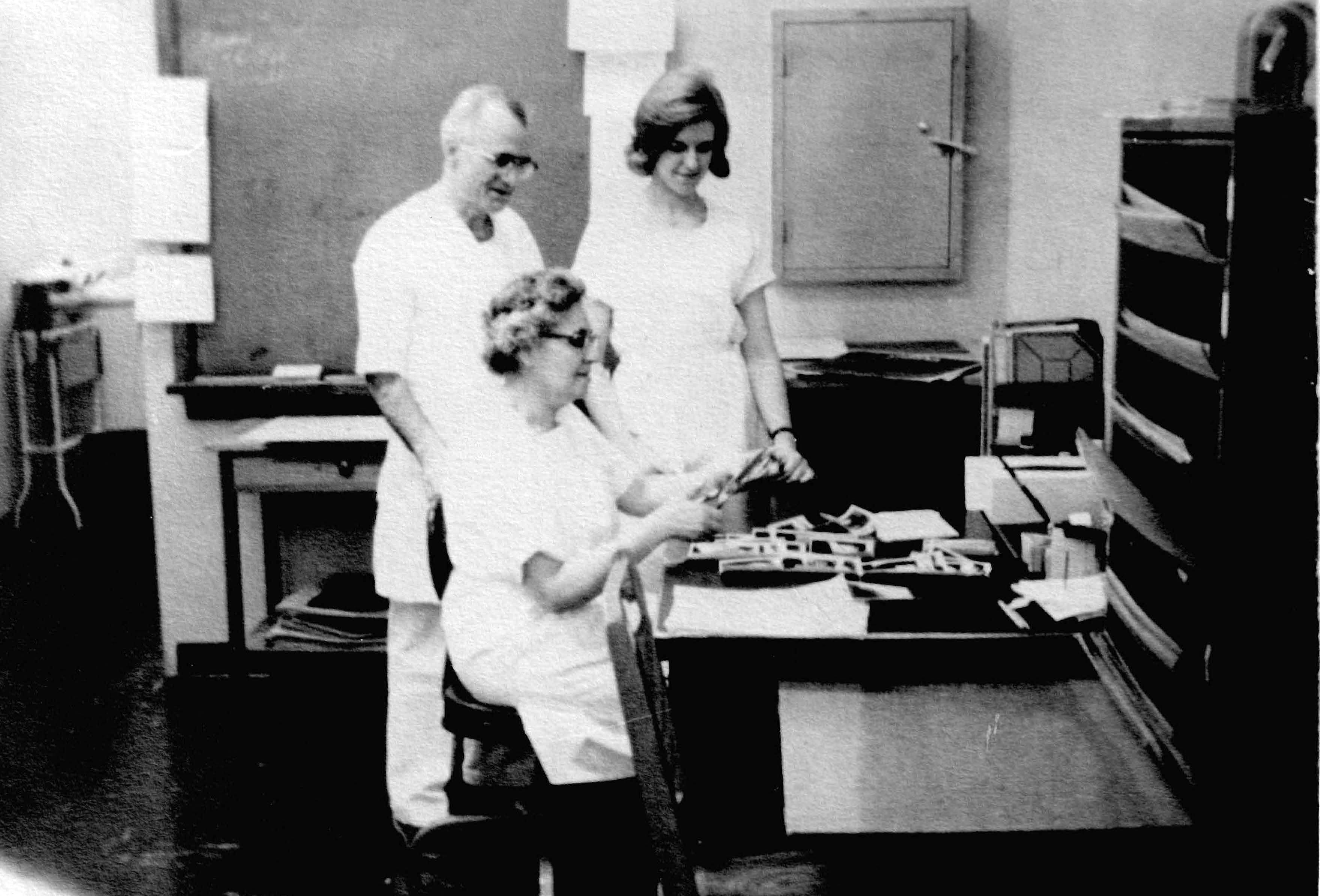
Dad’s office was in the East Wing of the
main building complex. For some years he worked alone with Dr. Cowen, then he
became more independent and had an assistant, Elizabeth Seiler. In 1956 Celenie
Yanssens, a registered technician like Dad, was appointed assistant x-ray technician, and remained in that post for a number
of years, perhaps until the end of the TB phase of the hospital. This may be
the three of them in this photo.
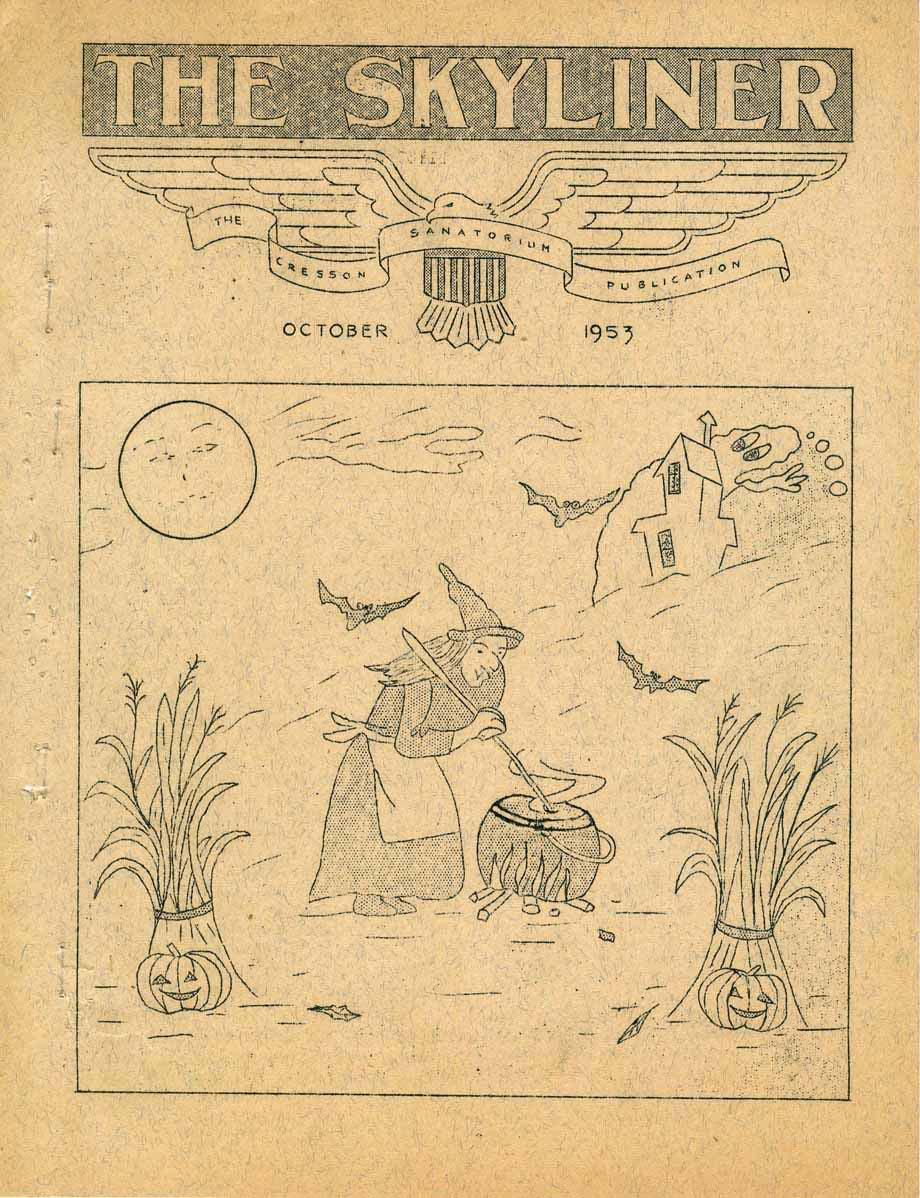
One of the things that Miss Mackereth insisted
that Dad learn early on was the ability to type. He became an excellent typist
– very fast – and he used that skill to tremendous productivity throughout his life. Among other things, he typed his son John’s 1973 328-page Ph.D. dissertation. One of the tasks he took on as a volunteer was editor of the monthly Skyliner
Magazine, much of which he typed himself. A complete issue is at this link: http://www.feltondesignanddata.com/cressontbsanatoriumremembered/id132.html
Dad did this for years, we think until the TB
sanatorium was converted to its succeeding purpose. Unfortunately, few editions
of the magazine have survived. John remembers a stack of them in the corner of
our parents’ bedroom that served as his home office, but they disappeared over the years.
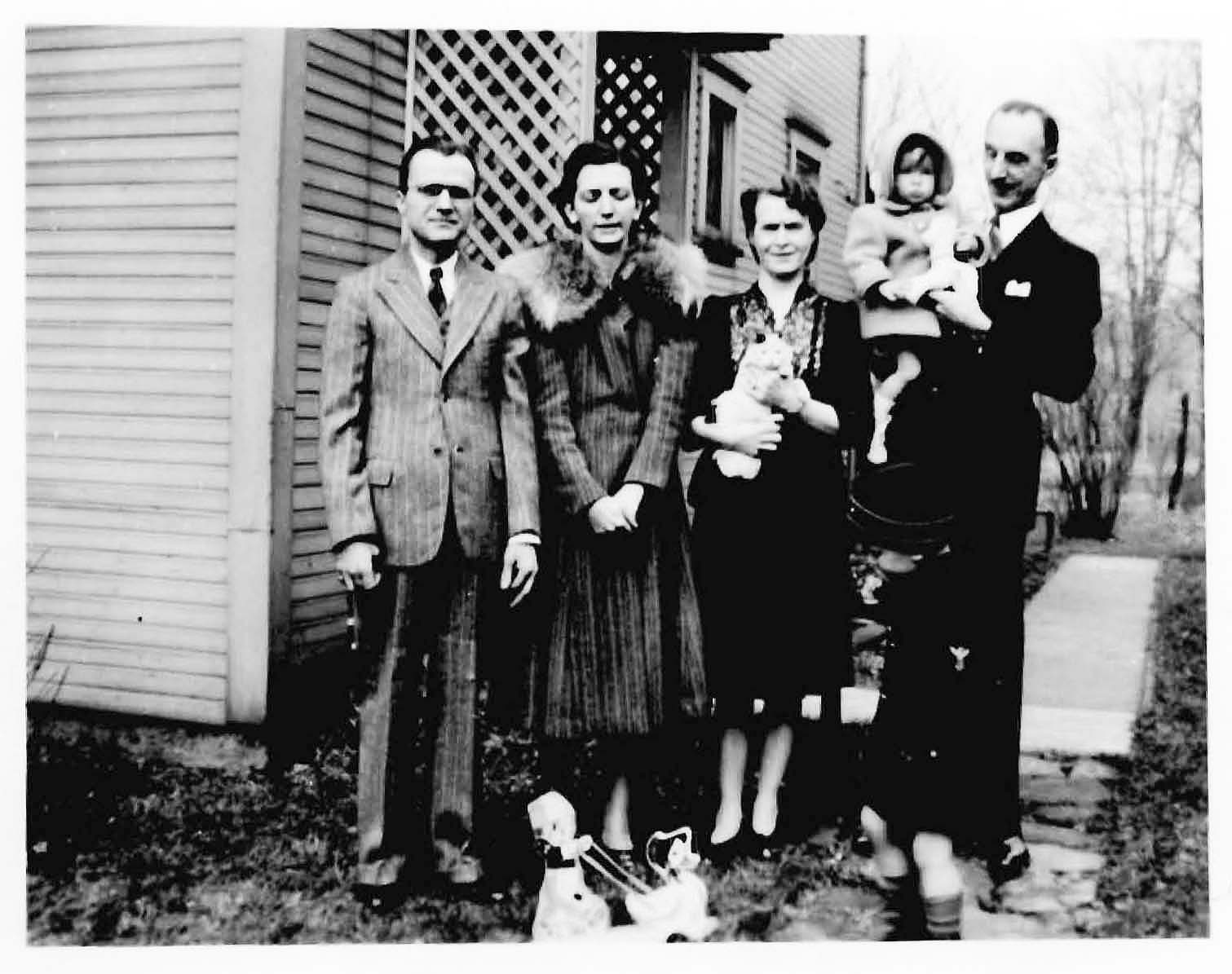
Eugene and Martha Kuhn became close long-term
friends of our parents. Eugene Kuhn was the Business Manager at the hospital, and our families were very close as we were growing
up. This picture shows our parents and the Kuhns in about 1943. Alta Sue and young Joe are in the picture, but Joe is in front of Mr. Kuhn and is not very visible. Mrs. Kuhn is holding a cat. The Kuhns
shared our family’s strong interests in music. Mr. Kuhn conducted our church
choir for as long as we can remember.
Dad made many life-long friends at the hospital. We had a huge Christmas card list. Names
we recall in particular are former patients Deszo Demetsky of Pittsburgh, Wilbur Best of West Newton, Ben Ananea of Punxsutawney, John Stains of DuBois; Doctors Melvin Cowen,. Tressler, and John Jones; staff members
Mary Mackereth, Betty Boyle, Emma Elswick, Elizabeth Seiler, Albin Soderholm (who worked at the San even longer than Dad),
among others. Dad also mentions in his diaries some of his early friendships
with patients Harvey Engle, Clara Vansickle, Harry Heise, Mike Sliman, Margaret Rabini,
Steve Zumas, Orville Iwig and Steve Rudolph.
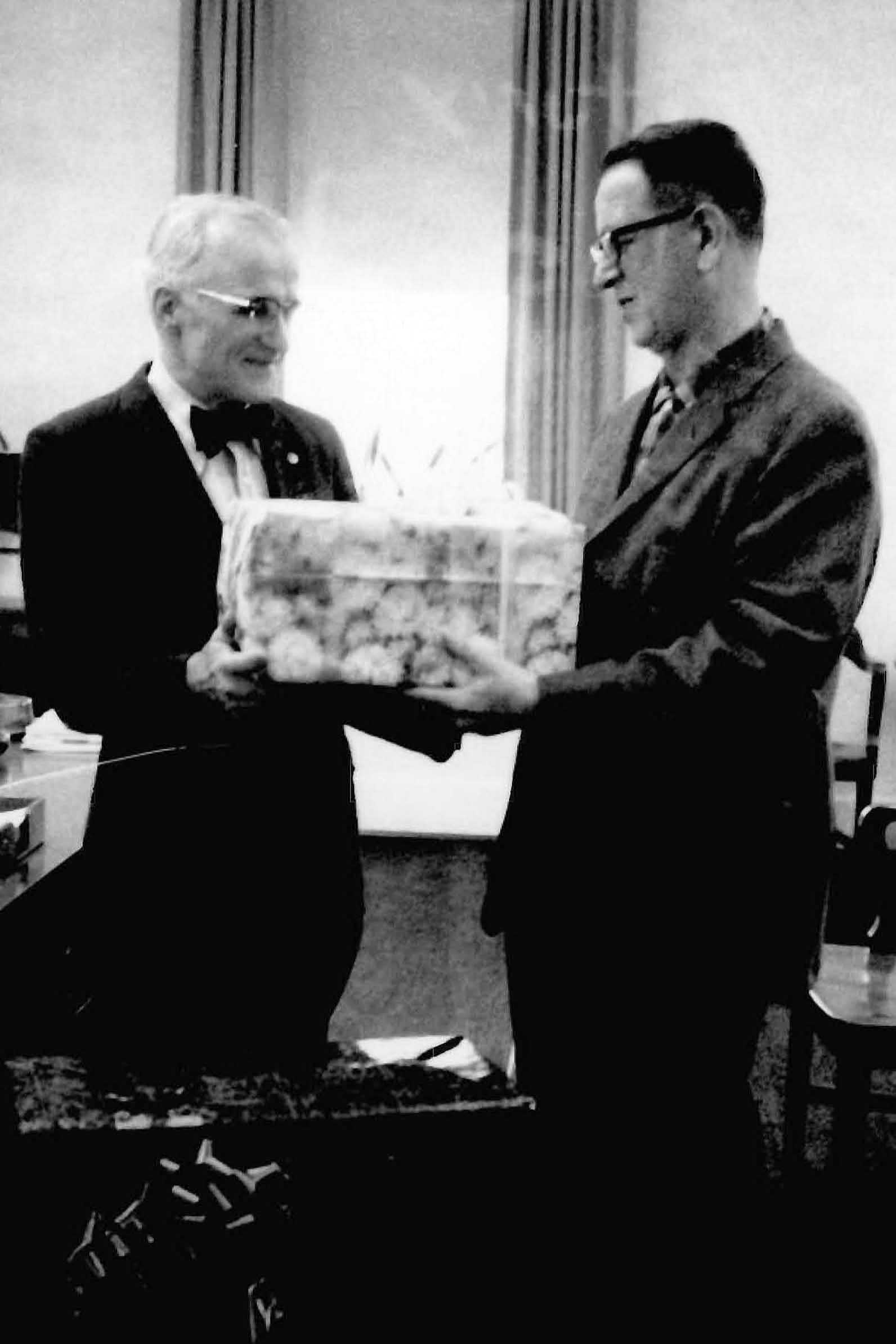
Dad retired about 1973 and was given a Voltmeter
as a retirement gift. John still has the instrument. It is significant that Dad, who could not stand to waste anything, somehow arranged to receive this rather
than a typical gift, like a clock, watch, or pen as his retirement gift. Joseph
Hajdu was a remarkably versatile handy man and hobbyist. He completely re-wired
our house in Cresson, and there were occasional problems, so the Voltmeter was a useful gift for him in his retirement years. Dad was always making something, but usually out of wood. In our house were materials
recycled from items discarded from the San, like partitions and two-drawer chests of drawers from the hospital wards that
Dad bought when they were surplused in the 1950s. The partitions were used to
finish the ceiling of our attic, which took on a warm half-timbered appearance.
Shortly before his passing in 1985 Dad began to
dictate his memoirs into a voice-activated cassette tape recorder that John sent him.
Unfortunately he never finished, but he did get through much of his time at the San.
His younger sister, Ethel, transcribed the memoirs into a typescript. The
portions that relate to his time at the San are given below. He also kept a detailed
daily diary from 1929 through 1933. Some excerpts are given below.
Dad was the only son of a coal miner/farmer/shoe
cobbler. He had three sisters. His
exile to the San at a young age had to have been a traumatic experience for him and his family. But he had a way of making lemonade out of life’s lemons, and he certainly made the best of his circumstances. A doctor once told him he should not expect to live to the age of forty, but thanks
to his excellent personal habits and modern medicine he made it past the Biblical three scores and ten. He died of pneumonia in 1985 at the age of 74. Through the
San he came into contact with educated people, met our mother, developed a great appreciation of education, and established
a career in medicine. His personal advancement had a profound impact on our family. He, our mother, and their families and friends left us a marvelous legacy of memories.
The Hajdu children: Joseph, John and Wilda
January 2011 |
|